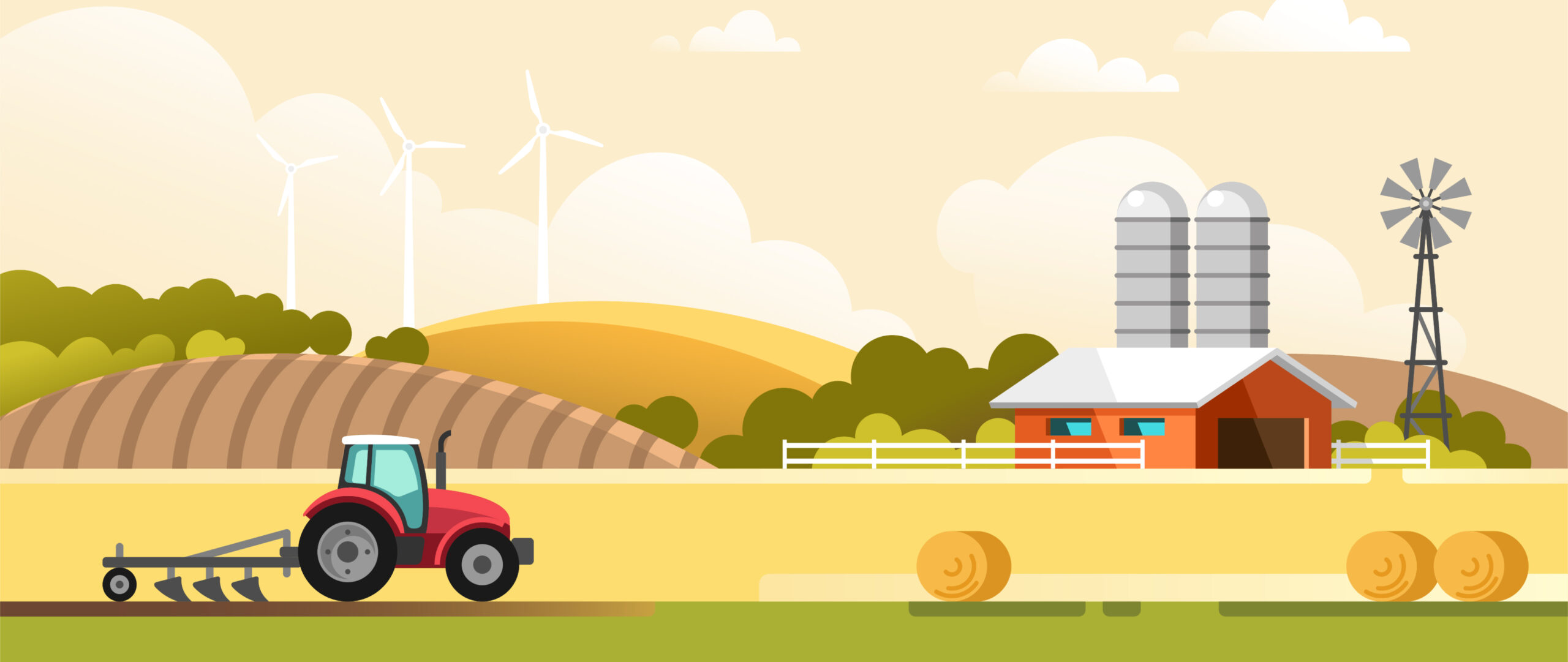2D animations are rapidly gaining importance in the agricultural sector. Whether it’s training videos for farmers, clear process visualizations, or interactive learning formats, animated content makes it easier to grasp complex topics while increasing efficiency and motivation. Technical innovations, ecological regulations, and modern operational processes are quickly explained, leading to better yields, sustainable practices, and more effective knowledge transfer.
Overview of the Current State of Agriculture
Agriculture in Germany is undergoing a profound transformation. In recent years, the number of farms has been steadily declining: between 2010 and 2020, around 35,600 farms disappeared. One key reason is rising operating costs, along with increasing lease and purchase prices for land, which particularly impact smaller farms.
At the same time, organic farming is becoming increasingly important. Nearly 37,000 farms — around 14.2% of all agricultural businesses — now operate organically and must adhere to various ecological regulations and Common Agricultural Policy (CAP) requirements. As a result, it is becoming ever more crucial to quickly and clearly communicate new knowledge, techniques, and innovations to ensure progress in individual farms.
The Role of Technology and Innovation in the Agricultural Sector
To remain economically viable despite increasing demands and limited resources, farmers are increasingly adopting modern technologies. From digital management tools and sensor-based solutions to automated feeding and milking systems, the industry has recognized that innovations can lead to higher yields, greater sustainability, and reduced labor effort.
- Digital Field Monitoring: Drones, satellite images, and weather data help detect plant diseases early and implement targeted countermeasures.
- Precision Farming: Sensors measure soil moisture and nutrient levels, allowing for precise water and fertilizer application.
- Automated Systems: Self-driving tractors and barn robots reduce physical labor and ease the workload on farm workers.
- Illustrations & 2D Animations: Used as tools for marketing and training, they simplify the use of new software functions and machine operations.
Especially in projects where multiple farms collaborate on EU-funded initiatives, clear communication is crucial. The integration of digital learning content enhances knowledge transfer and ensures smooth cooperation.

Why 2D Animation Will Be Relevant for Farmers in 2025
The agriculture of the future requires simple, cost-effective, and efficient ways to transfer knowledge and train employees. In an industry that relies heavily on visual learning and hands- on guidance, animated content is a game-changer. 2D animations can break down complex processes into easily digestible visuals, making them an ideal tool for fast and long-lasting knowledge transfer.
By strategically combining 2D and 3D elements, farmers can maximize clarity and effectiveness in training materials. Whether explaining mixed maize cultivation, summer crops, or winter plowing, animated scenes illustrate how different processes interact.
Farmers navigating GAP compliance standards or ensuring minimum soil cover also benefit from accessible, easy-to-understand explainer videos. 2D animation transforms extensive regulations into practical, real-world applications.
Increased Efficiency and Time Savings Through Animation
Animated explainer videos or instructional films can condense complex topics into just a few minutes — without costly on-site filming or long travel times for trainers. Especially in areas like crop planning, animal health, or smart farming systems, farmers benefit from:
- Faster Understanding – Animations clarify individual work steps better than text documents or static images.
- Cost-Effective Training – Once created, videos can be reused indefinitely, whether for onboarding new employees or training seasonal workers.
- Flexible Distribution – Whether on a smartphone, tablet, or PC, animated content is accessible anytime, anywhere — a major advantage in rural areas where in-person training is challenging.
- Higher Motivation and Engagement – Short, animated videos capture attention, making the learning process more engaging and effective.
This way, farmers save valuable time that they can invest in other essential tasks or direct fieldwork.
Clarity and Understanding of Complex Processes
A picture is worth a thousand words — and an animation even more. Especially when explaining technically complex topics, 2D animations can break down processes step by step. This is particularly useful for training employees or colleagues in new procedures that might seem abstract in theory:
- Crop Cultivation & Harvesting – Where and how should fertilization take place? How do crop rotation and soil conservation work? Animations can precisely visualize the journey from sowing to harvest.
- Animal Husbandry & Health – Whether vaccination schedules, barn hygiene, or feeding plans — animated explainer videos illustrate key procedures in a clear and engaging way.
- Sustainable Farming – Topics like soil fertility, water management, and eco-regulations become easier to grasp with animated tutorials, helping farmers understand how to implement new laws and guidelines in practice.
The benefits are obvious: By presenting processes visually and dynamically, you enhance comprehension and ensure the information sticks. This makes knowledge transfer in the agricultural sector of 2025 not just easier, but far more effective.
Applications of 2D Animation in the Agricultural Sector
Animations have already made their way onto modern farms. They not only make training more accessible but also help explain complex processes from the field to the barn in a clear and engaging way.
Training Videos for Farmers
Imagine learning new cultivation methods, machine settings, or fertilization strategies through engaging, easy-to-understand short films — without thick manuals or complicated texts. That’s exactly what 2D-animated training videos offer. They present even complex topics in a way that allows you to grasp the essentials in just a few minutes.
- Immediate Application – The demonstrated processes are easy to transfer into daily work, as they are shown step by step.
- Time-Saving – Once produced, animations can be used repeatedly — whether for training new employees or as a refresher course for your team.
- Higher Motivation – Instead of reading through dry theory, you learn visually and interactively, focusing on what truly matters in practice.
Success stories from other farms can also be illustrated through animation. For example, if a farm has already successfully implemented grazing concepts or innovations in summer crops, this journey can be shown step by step in videos — making learning more relatable and actionable.
Visualization of Cultivation and Harvesting Processes
When growing field crops, fruit, or wine, farmers often face questions about optimal planting schedules, harvesting times, and machinery operations. 2D animations can clearly illustrate the entire production cycle — from sowing and growth to harvesting.
- Better Understanding of Complex Processes – You can clearly see when and how each step connects in the workflow.
- Comparison of Different Methods – Animations allow you to visualize various scenarios, making it easier to assess the advantages and disadvantages of different cultivation or harvesting techniques.
- Fewer Errors, Higher Yields – When everyone involved knows exactly what to do, it improves the quality of your products and reduces failure rates.
Use in Animal Breeding and Care
In livestock farming, 2D animations can help you and your team adapt efficiently to new feeding or hygiene standards. Animated videos are particularly useful for topics like barn climate, vaccination schedules, and feeding routines.
- Clear Demonstration – Step-by-step visuals show exactly how to vaccinate animals properly or adjust them to new feeding plans.
- Health Promotion – A well-illustrated explanation of hygiene protocols encourages consistent implementation, improving animal welfare and overall productivity.
- Easier Onboarding – For new employees, animations serve as an easy-to-understand guide for essential routines.
Advantages of 2D Animation for Farmers
Wondering what 2D animations can do for your farm? They simplify learning, reduce costs, and allow you to reach a broad audience — whether regionally or even internationally.
Enhancing Learning and Knowledge Transfer
Agriculture is complex, with weather, soil properties, and animal health all playing crucial roles. 2D animations break down these intricate processes into clear, structured visuals, making them easier to understand and retain long-term.
- Higher Learning Efficiency – Visual insights speed up process comprehension much faster than text alone.
- Diverse Topics – Whether crop cultivation, animal husbandry, or farm management, almost any area can be explained with animation.
- Practical Application – Animations simulate real-world scenarios, seamlessly linking theory to practice.
Cost Reduction Through Digital Solutions
In-person seminars and workshops are often expensive and time-consuming — especially when bringing in external experts. 2D animations, on the other hand, allow you to professionally produce training content once and reuse it indefinitely.
- Less Travel & Work Downtime – Instead of pulling employees away from the fields or barns, you can offer on-site digital training.
- Scalable Knowledge Transfer – Whether for small teams or large agricultural enterprises, animated videos adapt to your needs.
- Long-Term Investment – High-quality animations retain their value for years, making them a one-time investment with lasting benefits.
Expanding Reach & Accessibility of Training
In rural areas, offering and attending regular training sessions can be challenging. With 2D animated videos, training becomes location-independent and easily accessible.
- Mobile Accessibility – Watch training content anytime on a smartphone, tablet, or PC — even out in the field.
- Tailored for Your Audience – Customize style, language, and detail level to match your team’s or farmers’ needs in specific regions.
- International Usability – With multiple language versions or subtitles, animated training videos can be quickly adapted for global use.
Trends and Developments in 2D Animation for 2025
Anyone who thinks 2D animation is only for simple comic clips is mistaken: In recent years, the field has expanded significantly. By 2025, new styles and technologies will continue to shake up the market.
- Minimalist Line Animations – Clean, simplified shapes are gaining popularity as they convey content quickly and effectively.
- Hand-Drawn Elements – This approach gives animations a unique look and creates a stronger emotional connection between viewers and the subject.
- Dynamic Gradients and Vibrant Typography – Especially in agricultural advertising, striking color transitions and bold fonts catch the eye instantly.
- Interactive Formats – Thanks to smart software, 2D animations can evolve into interactive learning tools, allowing educational content to be tailored even more precisely to specific businesses or individual needs.
The Future of 2D Animation in the Agricultural Sector
In 2025, 2D animation will be more essential than ever in making complex agricultural topics easy to understand. Whether in digital training sessions, webinars, or interactive farm management systems, animated sequences ensure that knowledge is conveyed effectively and tailored to the target audience.
New applications are constantly emerging: Virtual Reality (VR) and Augmented Reality (AR) can be combined with 2D elements to immerse farmers in realistic scenarios. For example, simulation-based training could allow them to practice harvesting or animal care virtually before applying it in real life.
Additionally, integrating 2D animation with other digital solutions — such as sensor data or AI- powered forecasting models — opens exciting possibilities. In the future, farmers could access real-time animated updates on when and how to plant or harvest, all from a tablet right in the field.
Conclusion
2D animation is no longer a niche topic. It plays a crucial role in making agricultural knowledge more accessible, cost-effective, and sustainable. Especially now, as growing conditions and market demands change rapidly, animated formats provide the flexibility needed to prepare farms and workers for the future.
From visually explaining complex cultivation processes to providing clear, structured animal care instructions, 2D animations help improve understanding and efficiency. In doing so, they support your efforts to practice environmentally, economically, and socially sustainable agriculture.
Frequently Asked Questions
What will change in agriculture in 2025?
Starting in 2025, significant changes will take effect in agriculture. Small farms with up to 10 hectares of agricultural land will no longer face penalties for violating conditionality requirements, though regulatory inspections will still apply. Additionally, social conditionality will be introduced, linking subsidies to compliance with labor conditions, workplace safety, and health protection standards.
For arable farming, stricter requirements will apply from 2025: Each field must grow at least two different main crops within three years. Furthermore, at least 33% of the arable land must undergo an annual crop rotation, or alternatively, a cover crop can be planted.
What does a 2D animator do?
A 2D animator creates hand-drawn images on flat surfaces or digital platforms, drawing a new frame for each movement. This results in dynamic animations that bring stories to life. What are the benefits of animated training videos for farmers? Animated training videos help farmers present complex information in a visually appealing and easy-to-understand way, making learning more effective. This plays a key role in improving their knowledge and skills.
Are 2D animations suitable for livestock topics?
Absolutely. Proper care, hygiene plans, and feeding concepts can be effectively illustrated through animated guides. This allows employees to quickly understand their tasks without having to sift through lengthy manuals.




